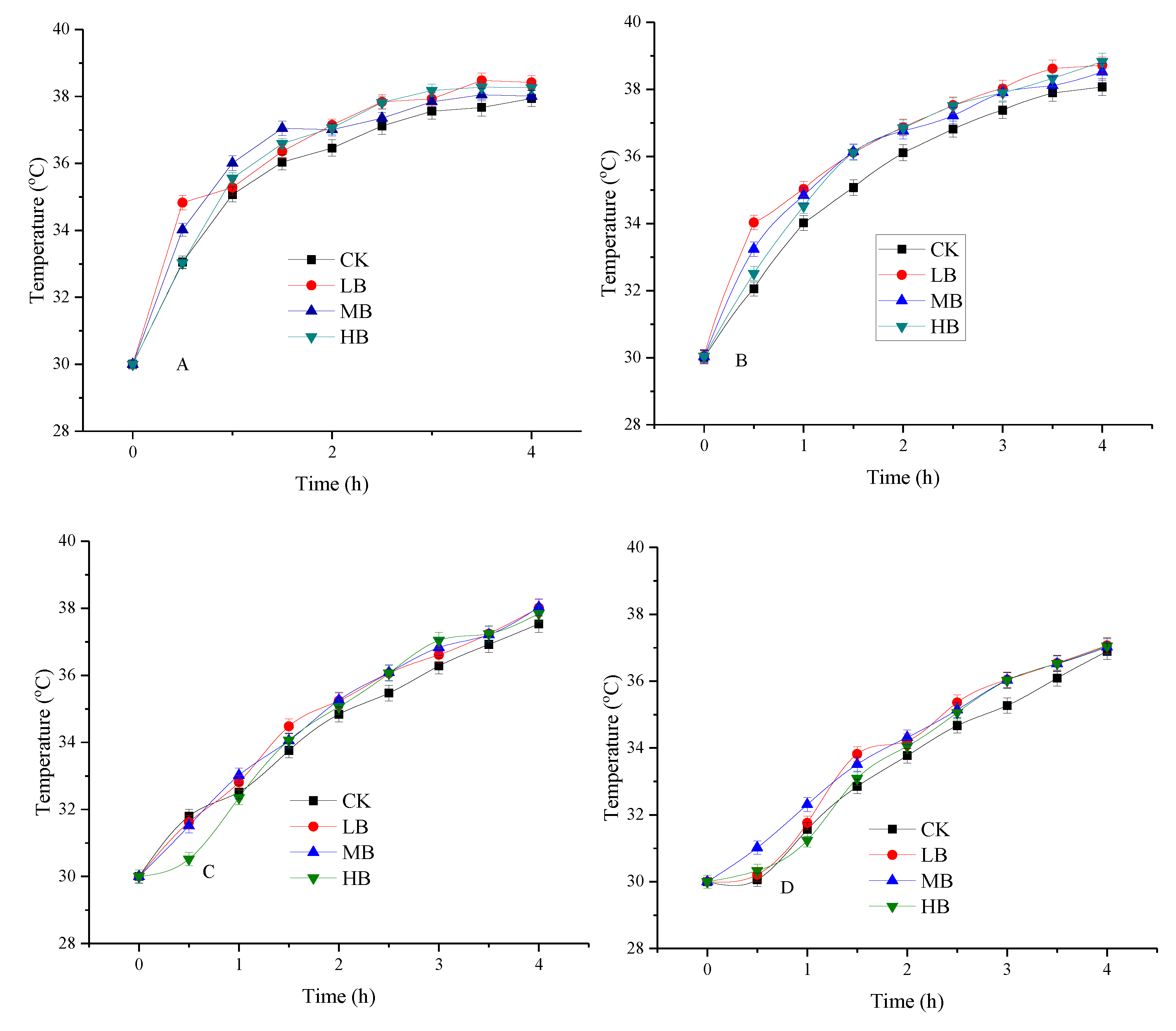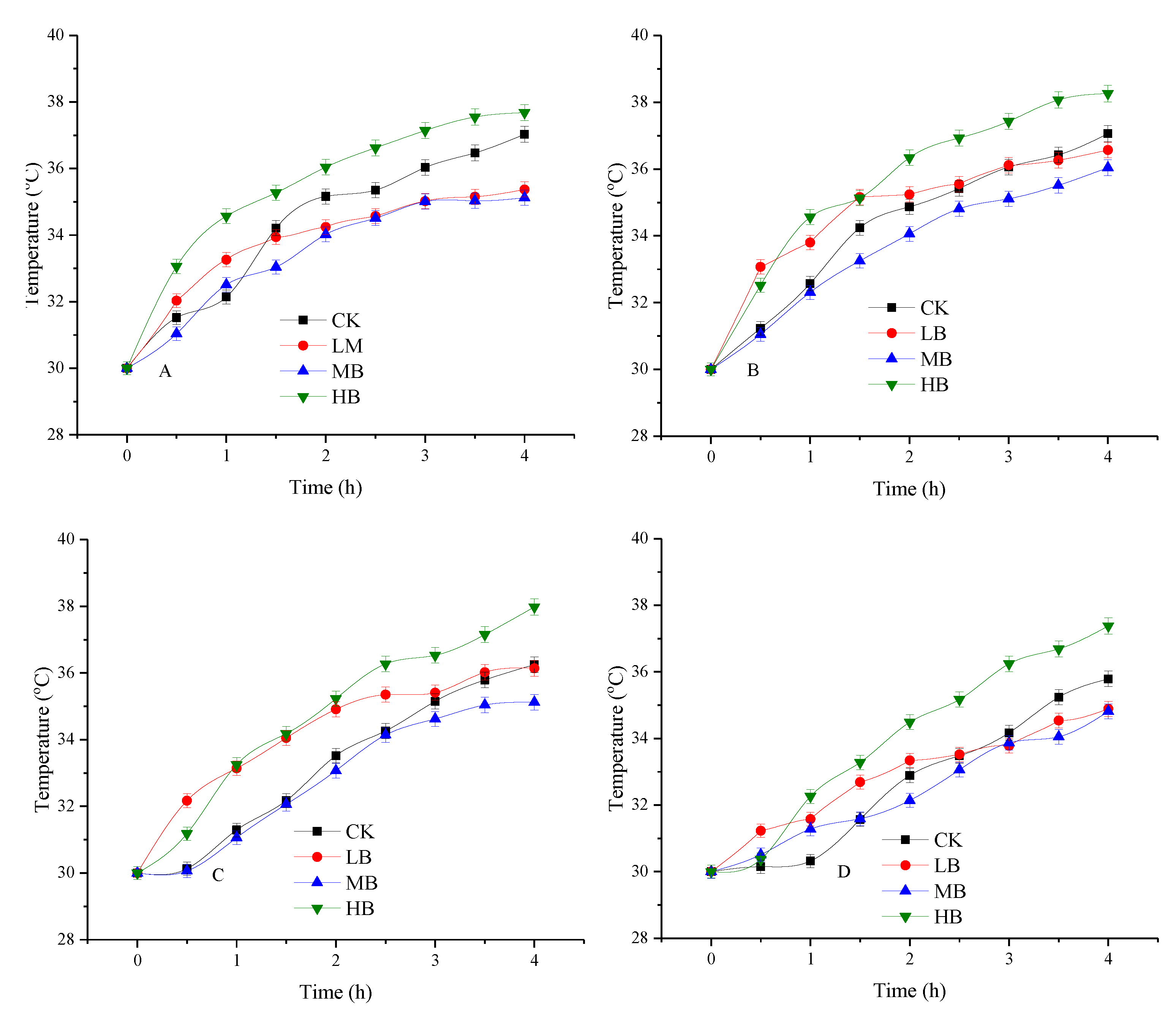Effect of Biochar on Soil Temperature under High Soil Surface Temperature in Coal Mined Arid and Semiarid Regions
Abstract
1. Introduction
2. Materials and Methods
2.1. Soil Used in Study
2.2. Wheat Straw Biochar Preparation
Characterization of WSB
2.3. Chamber Experiment
2.4. Statistical Design, Data Processing, and Analysis
3. Results and Discussion
3.1. Effect of WSB Application on Different Soil Heat Parameters and Their Relationships
3.2. Effect of WSB Application on Soil Temperature Variations at Different Soil Moisture Contents
3.2.1. Effect of WSB Application on Soil Temperature Variations at 10% Soil Moisture Contents
3.2.2. Effect of WSB Application on Soil Temperature Variations at 20% Soil Moisture Contents
4. Conclusions
Author Contributions
Funding
Conflicts of Interest
References
- Khoshkhoo, Y.; Jansson, P.E.; Irannejad, P.; Khalili, A.; Rahimi, H. Calibration of an energy balance model to simulate wintertime soil temperature, soil frost depth, and snow depth for 14 year period in a highland area of Iran. Cold Reg. Sci. Technol. 2015, 119, 47–60. [Google Scholar] [CrossRef]
- Mosier, A.R. Soil processes and global change. Biol. Fert. Soils 1998, 27, 221–229. [Google Scholar] [CrossRef]
- Abu-Hamdeh, N.H.; Reeder, R.C. Soil thermal conductivity: Effects of density, moisture, salt concentration, and organic matter. Soil Sci. Soc. Am. J. 2000, 64, 1285–1290. [Google Scholar] [CrossRef]
- Lei, S.; Bian, Z.; Daniels, J.L.; He, X. Spatio-temporal variation of vegetation in arid and vulnerable coal mining region. Min. Sci. Technol. 2000, 20, 485–490. [Google Scholar] [CrossRef]
- Qian, M.G. Technological system and green mining concept. Coal Sci. Technol. Mag. 2003, 4, 1–3. [Google Scholar]
- Tripathi, N.; Singh, R.S.; Singh, J.S. Impact of post-mining subsidence on nitrogen transformation in southern tropical dry deciduous forest, China. Environ. Res. 2009, 109, 258–266. [Google Scholar] [CrossRef]
- O’Brien, P.L.; Hatfield, J.L. Extreme soil surface temperatures reflect need to rethink agronomic management. Agric. Environ. Lett. 2020, 5, 1–5. [Google Scholar] [CrossRef]
- Liu, B.; Henderson, M.; Wang, L.; Shen, X.; Zhou, D.; Chen, X. Climatology and trends of air and soil surface temperatures in the temperate steppe region of North China. Int. J. Clim. 2017, 37, 1199–1209. [Google Scholar] [CrossRef]
- Xu, X.; Luo, Y.; Zhou, J. Carbon quality and the temperature sensitivity of soil organic carbon decomposition in tallgrass prairie. Soil Biol. Biochem. 2012, 50, 142–148. [Google Scholar] [CrossRef]
- Xu, Q.; Huang, B. Growth and Physiological Responses of Creeping Bentgrass to Changes in Air and Soil Temperatures. Crop Sci. 2000, 40, 1363–1368. [Google Scholar] [CrossRef]
- Aidoo, M.K.; Bdolach, E.; Fait, A.; Lazarovitch, N.; Rachmilevich, S. Growth and Physiological Responses of Creeping Bentgrass to Changes in Air and Soil Temperatures. Plant Physiol. Bioch. 2016, 106, 73–81. [Google Scholar] [CrossRef] [PubMed]
- Lehmann, J.; Joseph, S. Biochar for Environmental Management: An introduction. In Biochar for Environmental Management: Science and Technology; Earthscan: London, UK, 2009; pp. 1–12. [Google Scholar]
- Montanarella, L.; Lugato, E. The Application of Biochar in the EU: Challenges and Opportunities. Agronomy 2013, 3, 462–473. [Google Scholar] [CrossRef]
- Razzaghi, F.; Obour, P.B.; Arthur, E. Does biochar improve soil water retention? A systematic review and meta-analysis. Geoderma 2019, 361, 114055. [Google Scholar] [CrossRef]
- Abel, S.; Peters, A.; Trinks, S.; Schonsky, H.; Facklam, M.; Wessolek, G. Impact of biochar and hydrochar addition on water retention and water repellency of sandy soil. Geoderma 2013, 202–203, 183–191. [Google Scholar] [CrossRef]
- Ding, Y.; Gao, X.; Qu, Z.; Jia, Y.; Hu, M.; Li, C. Effects of biochar application and irrigation methods on soil temperature in farmland. Water 2019, 11, 499. [Google Scholar] [CrossRef]
- Cheng, Z.L.; Lam, K.S.; Chan, L.Y.; Wang, T.; Cheng, K.K. Chemical characteristics of aerosols at coastal station in Hong Kong. I. Seasonal variation of major ions, halogens and mineral dusts between 1995 and 1996. Atmos. Environ. 2000, 34, 2771–2783. [Google Scholar] [CrossRef]
- Clare, A.; Barnes, A.; McDonagh, J.; Shackley, S. From rhetoric to reality: Farmer perspectives on the economic potential of biochar in China. Int. J. Agr. Sustain. 2014, 12, 440–458. [Google Scholar] [CrossRef]
- Cook, R.J.; Haglund, W.A. Wheat yield depression associated with conservation tillage caused by root pathogens in the soil not phytotoxins from the straw. Soil Biol. Biochem. 1991, 23, 1125–1132. [Google Scholar] [CrossRef]
- Gevaert, A.I.; Miralles, D.G.; de Jeu, R.A.; Schellekens, J.; Dolman, A.J. Soil moisture-temperature coupling in a set of land surface models. J. Geophys. Res. Atmos. 2018, 123, 1481–1498. [Google Scholar] [CrossRef]
- Lone, A.H.; Najar, G.R.; Ganie, M.A.; Sofi, J.A.; Ali, T. Biochar for sustainable soil health: A review of prospects and concerns. Pedosphere 2015, 25, 639–653. [Google Scholar] [CrossRef]
- Zhao, J.; Ren, T.; Zhang, Q.; Du, Z.; Wang, Y. Effects of biochar amendment on soil thermal properties in the North China Plain. Soil Sci. Soc. Amn. J. 2016, 80, 1157–1166. [Google Scholar] [CrossRef]
- Liu, Y.; Yang, S.; Lu, H.; Wang, Y. Effects of biochar on spatial and temporal changes in soil temperature in cold waterlogged rice paddies. Soil Tillage Res. 2018, 181, 102–109. [Google Scholar] [CrossRef]
- Li, Q.; Wang, M.; Fu, Q.; Li, T.; Liu, D.; Hou, R.; Li, H.; Cui, S.; Ji, Y. Short-term influence of biochar on soil temperature, liquid moisture content and soybean growth in a seasonal frozen soil area. J. Environ. Manag. 2020, 266, 110609. [Google Scholar] [CrossRef] [PubMed]
- Yan, Q.; Dong, F.; Li, J.; Duan, Z.; Yang, F.; Li, X.; Lu, J.; Li, F. Effects of maize straw-derived biochar application on soil temperature, water conditions and growth of winter wheat. Eur. J. Soil Sci. 2019, 70, 1280–1289. [Google Scholar] [CrossRef]
- Uno, U.E.; Emetere, M.E.; Adelabu, J.S. Parametric investigation of soil susceptibility to compaction using temperature deviation curves. Sci. J. Civ. Eng. Arch. 2012, 2012, 1–6. [Google Scholar]
- Zhang, Q.; Wang, Y.; Wu, Y.; Wang, X.; Du, Z.; Liu, X.; Song, J. Effects of biochar amendment on soil thermal conductivity, reflectance, and temperature. Soil Sci. Soc. Am. J. 2013, 77, 1478–1487. [Google Scholar] [CrossRef]
- Xiao, Q.; Zhu, L.X.; Shen, Y.F.; Li, S.Q. Sensitivity of soil water retention and availability to biochar addition in rainfed semi-arid farmland during a three-year field experiment. Field Crops Res. 2016, 196, 284–293. [Google Scholar] [CrossRef]
- Usowicz, B.; Lipiec, J.; Lukowski, M.; Marczewski, W.; Usowicz, J. The effect of biochar application on thermal properties and albedo of loess soil under grassland and fallow. Soil Tillage Res. 2016, 164, 45–51. [Google Scholar] [CrossRef]
- Wu, G.L.; Zhang, M.Q.; Liu, Y.; López-Vicente, M. Litter cover promotes biocrust decomposition and surface soil functions in sandy ecosystem. Geoderma 2020, 374, 114429. [Google Scholar] [CrossRef]
- Karimi, A.; Moezzi, A.; Chorom, M.; Enayatizamir, N. Application of biochar changed the status of nutrients and biological activity in a calcareous soil. J. Soil Sci. Plant. Nutr. 2020, 20, 450–459. [Google Scholar] [CrossRef]
- Oguntunde, P.G.; Abiodun, B.J.; Ajayi, A.E.; van de Giesen, N. Effects of charcoal production on soil physical properties in Ghana. J. Plant Nutr. Soil Sci. 2008, 171, 591–596. [Google Scholar] [CrossRef]
- Herath, H.M.S.K.; Camps-Arbestain, M.; Hedley, M. Effect of biochar on soil physical properties in two contrasting soils: An Alfisol and an Andisol. Geoderma 2013, 209, 188–197. [Google Scholar] [CrossRef]


| Treatments | Bulk Density (kgm−3) | Thermal Conductivity (Wm−1K−1) | Volumetric Heat Capacity (MJm−3K−1) | Thermal Diffusivity (10−7m2s−1) | |
|---|---|---|---|---|---|
| Moisture content (10%) | CK | 1790 a | 1.17 a | 1.94 a | 6.04 a |
| LB | 1380 b | 0.87 b | 1.61 b | 5.41 b | |
| MB | 1300 c | 0.68 c | 1.52 b | 4.46 c | |
| HB | 1170 d | 0.47 d | 1.35 c | 2.97 d | |
| Moisture content (20%) | CK | 2270 a | 2.01 a | 2.80 a | 7.18 a |
| LB | 2220 b | 2.08 a | 2.92 a | 7.13 b | |
| MB | 1930 c | 1.67 b | 2.56 b | 6.53 c | |
| HB | 1710 d | 0.88 c | 2.27 c | 3.87 d |
| Parameter | Soil Bulk Density | Moisture Content |
|---|---|---|
| soil bulk density | 0.81 ** | |
| thermal conductivity | 0.96 ** | 0.75 ** |
| volumetric heat capacity | 0.91 ** |
© 2020 by the authors. Licensee MDPI, Basel, Switzerland. This article is an open access article distributed under the terms and conditions of the Creative Commons Attribution (CC BY) license (http://creativecommons.org/licenses/by/4.0/).
Share and Cite
Xiong, J.; Yu, R.; Islam, E.; Zhu, F.; Zha, J.; Sohail, M.I. Effect of Biochar on Soil Temperature under High Soil Surface Temperature in Coal Mined Arid and Semiarid Regions. Sustainability 2020, 12, 8238. https://doi.org/10.3390/su12198238
Xiong J, Yu R, Islam E, Zhu F, Zha J, Sohail MI. Effect of Biochar on Soil Temperature under High Soil Surface Temperature in Coal Mined Arid and Semiarid Regions. Sustainability. 2020; 12(19):8238. https://doi.org/10.3390/su12198238
Chicago/Turabian StyleXiong, Jibing, Runhua Yu, Ejazul Islam, Fuhai Zhu, Jianfeng Zha, and Muhammad Irfan Sohail. 2020. "Effect of Biochar on Soil Temperature under High Soil Surface Temperature in Coal Mined Arid and Semiarid Regions" Sustainability 12, no. 19: 8238. https://doi.org/10.3390/su12198238
APA StyleXiong, J., Yu, R., Islam, E., Zhu, F., Zha, J., & Sohail, M. I. (2020). Effect of Biochar on Soil Temperature under High Soil Surface Temperature in Coal Mined Arid and Semiarid Regions. Sustainability, 12(19), 8238. https://doi.org/10.3390/su12198238






